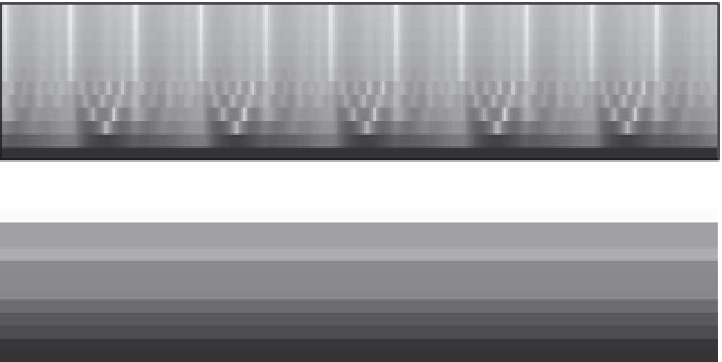Biomedical Engineering Reference
In-Depth Information
STFT (TIME VS. FREQUENCIES)
1/2
Period
Window
10
5
0
0
100
200
300
400
500
10
1
Period
Window
5
0
0
50
100
150
200
250
300
350
400
450
500
10
2
Period
Window
5
0
0
20
40
60
80
100
120
140
160
180
TIME (ms)
FIGURE 11.30
A two-dimensional rendering of the STFT amplitude coefficients for three box window sizes—
½ period, 1 period, and 2 periods—applied to the perfectly periodic data shown in Figure 11.17. The lighter the
color, the larger the amplitude. For example, the 0th row corresponds to the mean term of the transform, which
is the largest in all cases. Higher rows correspond to harmonics of the data, which, in general, decrease with fre-
quency. The vertical lines in the top figure are indicative of longer periodicities than the window. The solid-colored
horizontal lines in the bottom two figures indicate that the frequency content is totally independent of time at that
window size. The dark (little or no frequency content) horizontal lines interspersed with the light lines in the
bottom figure indicate that multiple periods exist within the window.
In contrast, Figure 11.31 shows an amplitude STFT spectrum for the aperiodic pressure
waveform shown in Figure 11.2, with the window size matched as closely as possible to
the heart rate. The mean has been removed from the signal so the variation in the lowest
frequencies (frequency level 0) reflects changes with respiration. The level of the heart rate
(level 1) is most consistent across time, and the variability increases with frequency.
The main disadvantage of the STFT is that the width of the window remains fixed
throughout the analysis. Wavelet analysis represents a change from both the FT and STFT
in that the constituent signals are no longer required to be sinusoidal and the windows
are no longer of fixed length. In wavelet analysis, the signals are broken up into shifted
and scaled versions of the original or “mother” wavelet,
(t). Figure 11.32 shows examples
of two wavelets: the Haar on the left and one from the Daubechies (db2) series on the right.
Conceptually, these mother wavelet functions are analogous to the impulse response of a
band-pass filter. The sharp corners enable the transform to match up with local details that
are not possible to observe using a Fourier transform.
c
























































































